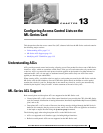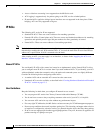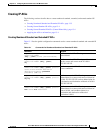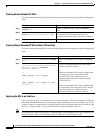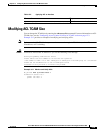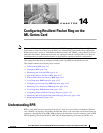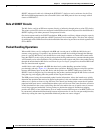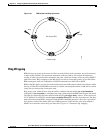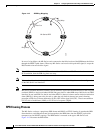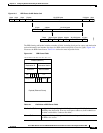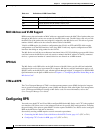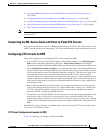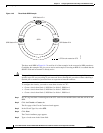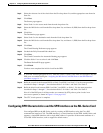
14-2
Cisco ONS 15310-CL and Cisco ONS 15310-MA Ethernet Card Software Feature and Configuration Guide R8.5
78-18133-01
Chapter 14 Configuring Resilient Packet Ring on the ML-Series Card
Understanding RPR
SONET, when used in this role. Although the IEEE 802.17 draft was used as reference for the Cisco
ML-Series RPR implementation, the current ML-Series card RPR protocol does not comply with all
clauses of IEEE 802.17.
Role of SONET Circuits
The ML-Series cards in an SPR must connect directly or indirectly through point-to-point STS circuits.
The point-to-point STS circuits are configured on the ONS node and are transported over the ONS node’s
SONET topology with either protected or unprotected circuits.
On circuits unprotected by the SONET mechanism, RPR provides resiliency without using the capacity
of the redundant protection path that a SONET protected circuit would require. This frees this capacity
for additional traffic. RPR also utilizes the bandwidth of the entire ring and does not block segments like
STP or RSTP.
Packet Handling Operations
When an ML-Series card is configured with RPR and is made part of an SPR, the ML-Series card
assumes a ring topology. If a packet is not destined for network devices bridged through the Ethernet
ports of a specific ML-Series card, the ML-Series card simply continues to forward this transit traffic
along the SONET circuit, relying on the circular path of the ring architecture to guarantee that the packet
will eventually arrive at the destination. This eliminates the need to queue and process the packet flowing
through the nondestination ML-Series card. From a Layer 2 or Layer 3 perspective, the entire RPR looks
like one shared network segment.
An ML-Series card configured with RPR has three basic packet-handling operations: bridge,
pass-through, and strip. Figure 14-1 illustrates these operations. Bridging connects and passes packets
between the Ethernet ports on the ML-Series and the packet-over-SONET (POS) ports used for the
SONET circuit circling the ring. Pass-through lets the packets continue through the ML-Series card and
along the ring, and stripping takes the packet off the ring and discards it.
The RPR protocol, using the transmitted packet's header information, allows the interfaces to quickly
determine the operation that needs to be applied to the packet. It also uses both the source and destination
addresses of a packet to choose a ring direction. Flow-based load sharing helps ensure that all packets
populated with equal source- and destination-address pairs will be sent in the same direction, and arrive
at their destination in the correct order. Ring direction also enables the use of spatial reuse to increase
overall ring aggregate bandwidth. Unicast packets are destination stripped. Destination stripping
provides the ability to have simultaneous flows of traffic between different parts of an RPR. Traffic can
be concurrently transmitted bidirectionally between adjacent nodes. It can also can span multiple nodes,
effectively reusing the same ring bandwidth. Multicast packets are source stripped.




